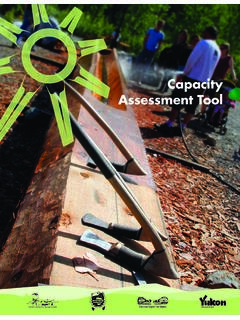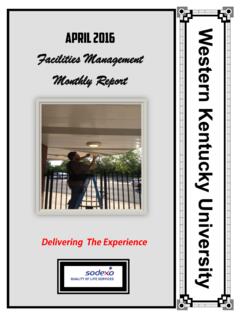Transcription of Construction Code of Practice for the Sustainable Use of ...
1 Code of Practicefor the Sustainable Use of Soilson Construction SitesDepartment for Environment, Food and Rural AffairsNobel House17 Smith SquareLondon SW1P 3 JRTelephone: 020 7238 6000 Website: Crown copyright 2009 Copyright in the typographical arrangement and design rests with the publication (excluding the royal arms and departmental logos) may be reused free of charge inany format or medium provided that it is reused accurately and not used in a misleading material must be acknowledged as crown copyright and the title of the publication about this publication and further copies are available from:DefraSoils Policy Team3C Nobel HouseLondon SW1P 3 JRTelephone: 020 7238 6419 Website: document is also available on the Defra ://defraweb/environment/land/ by the Department for Environment, Food and Rural Image: Soils on Construction Sites, photo courtesy of the 20091 ContentsSummary2 About this Soil Soil and construction42 Related Waste Other legislation93 Related guidance104 Pre- Construction Knowing what soils are on site13 Case Study 1: Amenity area of residential development165 Soil management during On-site soil management20 Case Study 2: Comprehensive soil care for Channel Tunnel Rail Topsoil Subsoil Soil stockpiling27 Case Study 3: Poor gardens of housing development necessitate 90,000 of remedial work306 Landscape, habitat or garden Soil placement33 Case Study 4: Decisions not to follow soil specifications cost company 25, Sourcing and importing topsoil38 Case Study 5: Prestige residential development benefits from careful soil investigationand Topsoil manufacture44 Case Study 6.
2 Cost saving of 400,000 on major brownfield site Construction Soil Uses for surplus topsoil50 References53 Glossary55 Acknowledgements58 Summary2 Soil is a fundamental and ultimately finite resource that fulfils a number of functions and servicesfor society which are central to sustainability. Some of the most significant impacts on thisresource occur as a result of activities associated with Construction activity, yet it appears that thereis a general lack of awareness and understanding of this need within the Construction Code of Practice has therefore been developed to assist anyone involved in the constructionsector to better protect the soil resources with which they work. By following the guidance in theCode you will not only be able to help protect and enhance the soil resources on site but you mayalso achieve cost savings for your summary of the key messages in this Code of Practice is set out below:Pre- Construction planning Have a soil resource survey carried out on site by a suitably qualified and experienced soilscientist or practitioner ( a member of the Institute of Professional Soil Scientists ) at the earliest convenience and prior to any earthworks operations.
3 Incorporate the results of the soil resource survey into the site working strategy ( SiteWaste Management Plan or Material Management Plan) ensuring liaison between the soilresource survey and other ground investigations. Ensure that you are informed of and follow waste regulations as necessary. Consider the use of Sustainable drainage systems on site as these can provide more longterm protection of soils beyond the Construction phase, by facilitating the infiltration andattenuation of surface management during Construction Prepare a Soil Resource Plan showing the areas and type of topsoil and subsoil to bestripped, haul routes, the methods to be used, and the location, type and management ofeach soil stockpile. When stripping, stockpiling or placing soil, do so in the driest condition possible and usetracked equipment where possible to reduce compaction.
4 Confine traffic movement to designated routes. Keep soil storage periods as short as possible. Clearly define stockpiles of different soil , habitat or garden creation Ensure that the entire soil profile is in a condition to promote sufficient aeration, drainageand root growth. Safeguard and utilise on-site soil resources where possible. If importing soils, use a reputablesupplier, establish the source of the soil and ensure it is suitable for the intended this Code of Practice for the Sustainable use of soil on Construction sites is a practical guideto assist anyone involved in the Construction industry to protect the soil resources with whichthey work. It is particularly intended for use in contains guidance of interest to those involved at all stages of Construction projects, fromthe developer, designer, contractor, sub-contractor (earthworks, landscape) and the Code itself is not legislatively binding, by following it: you will help protect and enhance the soil resources on site and achieve wider benefits forthe environment; you may achieve cost savings for your business; it may help you to achieve your business sustainability targets.
5 And it may help you to meet legal obligations regarding waste Code outlines current guidance and legislation concerning the use of soil in constructionprojects, before offering stage by stage guidance on the use, management and movement ofsoil on protection, use and movement of soil should be considered from the outset of adevelopment project s planning, through its design and Construction phases and on intofuture Code provides guidance on the various stages of site development where soil should beconsidered and contains ten sections to provide practical advice on different aspects of usingsoil sustainably on Construction sites:i. Knowing what soils are on siteii. On-site soil managementiii. Topsoil strippingiv. Subsoil strippingv. Soil stockpilingvi. Soil placementvii. Sourcing and importing manufactureix. Soil aftercarex. Uses for surplus section explains the need for the advice and makes recommendations for goodpractice, including method statements, illustrations and a list of Do s and Don ts.
6 Code is complemented by Case Studies to demonstrate both good and poor Practice ,as well as a range of toolbox talks for use on Soil is a vulnerable and essentially non-renewable resource. One hectare of topsoil, the mostproductive soil layer, can contain up to 5 tonnes of living organisms and because it can takemore than 500 years to form a 2cm thickness, it is in practical terms fulfils a number of functions and services for society which are central to social,economic and environmental sustainability. These are: food and fibre production; environmental interaction (with water and air); support of ecological habitats and biodiversity; support for the landscape; protection of cultural heritage; providing raw materials; and providing a platform for also has a large social function, through providing the basis for greenspace, includinggardens, playing fields and public open space.
7 The latter provides cultural and social benefitsthat include increased well-being, physical and psychological health, and connection withnature. It consequently plays an important part in how people Soil and of the most significant impacts on soil properties occur as a result of activitiesassociated with Construction . Construction activity can have adverse impacts on soil in anumber of ways by: covering soil with impermeable materials, effectively sealing it and resulting in significantdetrimental impacts on soils physical, chemical and biological properties, includingdrainage characteristics; contaminating soil as a result of accidental spillage or the use of chemicals; over-compacting soil through the use of heavy machinery or the storage of constructionmaterials; reducing soil quality, for example by mixing topsoil with subsoil; and wasting soil by mixing it with Construction waste or contaminated materials, which thenhave to be treated before reuse or even disposed of at landfill as a last planning approval is a pre-requisite to all development proposals and considerationof the impact on soil is an integral part of the environmental assessment process, there is nospecific direct planning control on the Sustainable use and management of soil resources onconstruction sites or a requirement for the monitoring of soil protection and guidance provided in this Code will help achieve good soil management at all stages ofthe Construction addition to this Code, you should also consider the use of Sustainable drainage systems onsite as these can provide more long term protection of soils beyond the Construction phase.
8 By facilitating the infiltration and attenuation of surface water. Features such as permeablesurfaces reduce soil sealing and help to increase water infiltration and can increasegroundwater recharge, while swales and retention basins can temporarily collect surfacewater and reduce soil erosion from surface water Waste Sustainable use of soil on Construction sites is influenced by EU legislation related towaste, national recycling objectives and incentives, and UK regulation on or not waste? Construction industry is the largest single source of waste arisings in England, producing90 million tonnes of inert waste annually, some of it soil. Protection and reuse of soil isfundamental to initiatives to reduce such to the reuse of soil from Construction sites or redevelopment projects is the initialdetermination of whether the material in question is regarded as waste within the legaldefinition of the is no definitive list of what is and is not waste.
9 In determining whether surplus soil is oris not a waste, a number of tests have to be used to determine whether the material isbeing, is required to be, or is intended to be, Definition of Waste: Development Industry Code of Practice (DoWDICoP) is a voluntaryCode launched in September 2008 (applicable to England and Wales) that was initiated toprovide a clear and concise process to determine whether excavated materials on adevelopment site constitute waste in the first instance, and to identify the point when treatedwaste can no longer be considered as waste. This Code of Practice is no substitute forobtaining independent legal advice or for consulting the Environment on the definition of waste must be made in the light of all the specificcircumstances of an operation or activity and in accordance with the current case may be a certain degree of support between this Code of Practice for the SustainableUse of Soils on Construction Sites and the DoWDICoP, particularly when compiling a MaterialsManagement Plan and a Soil Resource Plan.
10 There is however a clear distinction between thetwo Codes. The Code of Practice for the Sustainable Use of Soils on Construction Sites is tobe used to protect soils and ensure adequate soil function ( plant growth, waterattenuation, biodiversity) during and after Construction . The DoWDICoP is to be used to helpdetermine whether materials on Construction sites are classified as waste or government objectives for waste management are outlined in the Waste Strategy forEngland 2007(Defra, 2007). Government is seeking to avoid the disposal of soil to landfillthrough recycling incentives and less onerous regulation of low-risk waste processes. A keytarget is to increase diversion of non-municipal waste (including soil) from landfill and tosecure better integration of treatment processes with the aim of reducing waste by makingproducts with fewer natural resources and a greater proportion of recycled reuse of soil is an important factor in the Waste Strategy and will consequentlycontribute to breaking the link between economic growth and waste growth with the dualbenefits of reduced environmental impact and the preservation of natural legislation6 Related legislation71 Environment Agency is responsible for enforcing waste management legislation inEngland and Wales (Scottish Environment Protection Agency in Scotland) and regulation isdischarged under the terms of the EU Waste Framework Directive.












